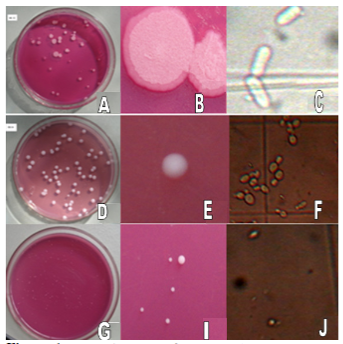Wild strains of fermenting yeast isolated of sugar cane juice from an alcohol distillery from Mato Grosso, Brazil
DOI:
https://doi.org/10.20873/jbb.uft.cemaf.v2n3.silvaPalabras clave:
Isolation, morphology, bioprospecting, biodiversity, fermentationResumen
Ethanol production for fuel is important for the Brazilian economy as a renewable solution to oil derivatives. The industrial process uses commercially available yeast, most of them isolated from sugar mills from the Brazilian state of São Paulo. The research information on the availability of yeast appropriate to the climatic conditions occurring in the Midwest region of Brazil is scarce. The article presents the isolation and morphological characterization of fermentative wild yeast prospected on the sugar cane juice of a sugar and alcohol mill of Mato Grosso State. The juice samples were collected in both the hot and rainy (HR) season and in the cold and dry (CD) one. The diluted sugar cane juice samples were plated on agar LWYN and evaluated for fermentation in test tubes containing inverted Durham tubes. From 26 morphotypes isolated, 50% were able to ferment sugar cane juice. Greater number and diversity of yeasts was found in both December (HR) and July (CD). In the remaining months of each season there were a low number of colonies with a poor diversity.
Citas
Andrietta, S. R.; Andrietta, M. G. S.; Rodrigues, M. I. (1995), Método de caracterização de leveduras de processo utilizando parâmetros cinéticos e produção específica. Stab/Açúcar, Álcool e Subprodutos, 4, 22-25.
APHA, American Public Health Association. (2001), Compendium of methods for the microbiological examination of foods. 4.ed. Washington, 64p.
Borba, C. M. and Rodrigues, K. F. (2000), Viability and sporulating capability of Coelomycetes preserved under a range of different storage regimes. Revista Iberoamericana de Micología, 17, 142-145.
Cabrini, K. T. and Gallo, C. R. (1999), Identificação de leveduras no processo industrial de fermentação alcoólica em usina do Estado de São Paulo, Brasil. Scientia Agricola, 1, 207-216.
Ceccato- Antonini, S. R.; Tosta, C. D.; Silva, A. C. (2004), Determination of yeast killer activity in fermenting sugarcane juice using selected ethanol-making strains. Brazilian Archives of Biology and Technology, 1, 13-23.
Ceccato-Antonini, S. R. (2010), Microbiologia da fermentação alcoólica. A importância do monitoramento microbiológico em destilarias. São Carlos: EduFSCar, 1, 105p.
Cid, V. J.; Sanchez, M.; Nombela, C. (1994), Characterization of thermosensitive autolytic mutants from diploid, Saccharomyces cerevisiae. Microbiology, 140, 559-68.
Costa, C. P.; Ferreira, M. C. (1991), Preservação de micro-organismos. Revista de Microbiologia, 3, 263-268.
Dorneles, D.; Machado, I. M. P.; Chociai, M. B.; Bonfim, T. M. B. (2005), Influence of the use of selected and non-selected yeasts in red wine production. Brazilian Archives of Biology and Technology. 48, 747-751.
Fermentec News, Disponível em: <http://www.fermentec.com.br/br/news/Ferment ec%20News%2002%20%202005.pdf> acesso em 28/01/2010.
Pataro, C.; Guerra, J. B.; Petrilho, P. M. L, Mendonça, H. Lc, Linardi, V. R.; Rosa, C. A. (2000), Yeast communities and genetic polymorphism of Saccharomyces cerevisiae strains associated with artisanal fermentation in Brazil. Journal of Applied Microbiology, 1, 24- 31.
Parrazi, C. and Oliveira, M. C. F. L. (1996), Comparação de linhagens de leveduras Saccharomyces cerevisiae floculantes em processo descontínuo de produção de álcool e aguardente In: Congresso Nacional da Stab, Anais, 1, 121-129.
Pelczar Jr, M. J.; Chan,E. C. S.; Krieg, N. R. (1996), Microbiologia: conceitos e aplicações. 2 ed. São Paulo: Makron Books do Brasil. 1, 524p.
Silva Filho, E. A. Caracterização genética de populações de leveduras de destilarias de álcool combustível para otimização do processo de fermentação. Tese (Doutorado em Biologia de Fungos) - Universidade Federal de Pernambuco, 2004.
Silva, L.; Ferreira, D.; Kamiya, N. F; Oliveira, M. S; Alterthum, F. (1992), Comparison of preservation methods applied to yeasts used for ethanol production in Brazil. Revista de Microbiologia, 3, 177-182.
Silva, C. V. F and Cereda, M. P. (2009), Isolamento de Leveduras Selvagens resistentes a radiação Ultravioleta do Caldo Fermentado de cana de açúcar (Sacharum officinarum) da cultivar RB-7515. CeTeAgro - Centro de Tecnologia e Análise para o Agronegócio. Universidade Católica de Campo Grande-MS.

Descargas
Publicado
Cómo citar
Número
Sección
Licencia
Copyright (c) 2024 - Journal of Biotechnology and Biodiversity

Esta obra está bajo una Licencia Creative Commons Atribución 4.0 Internacional.
Los autores que publican en esta revista aceptan los siguientes términos:
Los autores mantienen los derechos autorales y conceden a la revista el derecho de primera publicación, con el trabajo simultáneamente licenciado bajo la LicenciaCreative Commons Attribution (CC BY 4.0 en el link http://creativecommons.org/licenses/by/4.0/) que permite compartir el trabajo con reconocimiento de la autoría y publicación inicial en esta revista.
Los autores tienen autorización para asumir contratos adicionales separadamente, para distribución no exclusiva de la versión del trabajo publicado en esta revista (ej.: publicar en repositorio institucional o como capítulo de libro), con reconocimiento de autoría y publicación inicial en esta revista.
A los autores se les permite, y son estimulados, a publicar y distribuir su trabajo online (ej.: en repositorios institucionales o en su página personal) en cualquier punto antes o durante el proceso editorial, ya que esto puede generar alteraciones productivas, bien como aumentar el impacto y la citación del trabajo publicado (disponible en El Efecto del Acceso Libre en el link http://opcit.eprints.org/oacitation-biblio.html).


